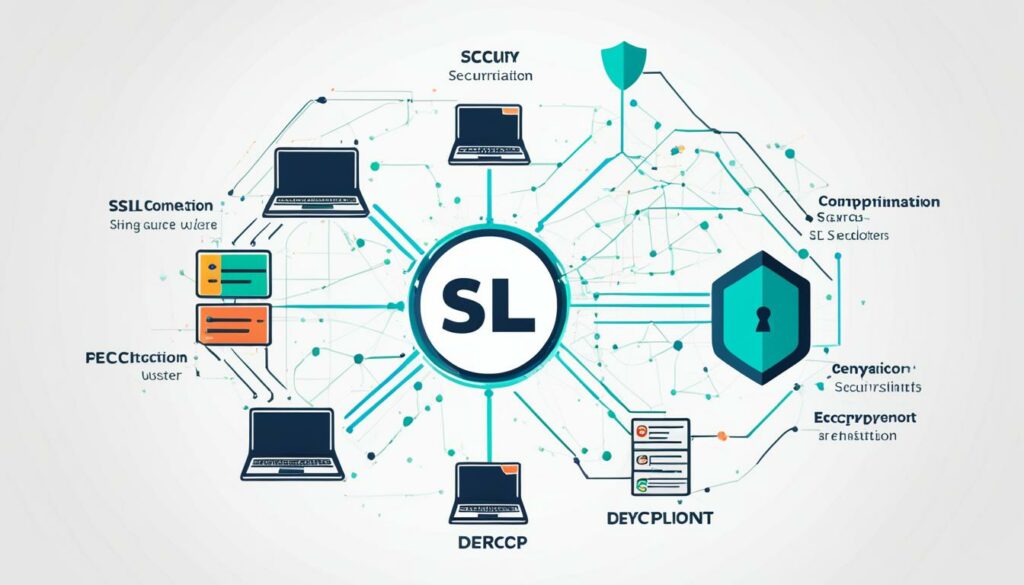In today’s digital age, ensuring secure online communication is more important than ever. With cyber threats on the rise, protecting sensitive data and maintaining user trust is a top priority for businesses and website owners. One essential aspect of online security is understanding TLS/SSL protocols and their role in establishing secure connections.
TLS (Transport Layer Security) and SSL (Secure Sockets Layer) are certificates that provide encryption, authentication, and data integrity, ensuring that the communication between browsers and web servers remains confidential and secure. While SSL is the predecessor to TLS, both terms are often used interchangeably, referring to the same type of certificates.
Implementing an SSL/TLS certificate on your website is crucial for establishing trust with both users and search engines. Users need to know that their personal information is protected when interacting with your site, and search engines prioritize secure websites in their rankings.
Key Takeaways:
- Understanding TLS/SSL protocols is crucial for ensuring secure online communication.
- TLS/SSL protocols provide encryption, authentication, and data integrity.
- Implementing an SSL/TLS certificate is essential for website security and user trust.
- SSL is the predecessor to TLS, but both terms are often used interchangeably.
- Search engines prioritize secure websites in their rankings.
What are TLS/SSL Protocols
TLS/SSL protocols are essential cryptographic protocols that ensure secure data transmission over the internet. When you browse the web, TLS/SSL protocols establish a secure connection between your browser and the web server, keeping your sensitive information confidential and safe from unauthorized access.
Wondering how TLS/SSL protocols work? It’s all about encryption and server verification. When data is transmitted, TLS/SSL protocols encrypt it, converting it into an unreadable format. Only the intended recipient with the correct decryption key can access and decipher the data.
To verify the authenticity of the server you’re connecting to, TLS/SSL protocols use public and private keys, certificate authorities, and encryption algorithms. This verification process ensures that you are communicating with the genuine server and not an imposter.
Importance of TLS/SSL Protocols
The importance of TLS/SSL protocols cannot be understated. These protocols play a crucial role in protecting against data breaches and ensuring the privacy and trustworthiness of your online communication. By encrypting your data and verifying server authenticity, TLS/SSL protocols safeguard your sensitive information from falling into the wrong hands.
Whether you’re sending personal details, financial information, or any other confidential data, TLS/SSL protocols provide a secure shield against potential threats and vulnerabilities. Implementing TLS/SSL protocols is a fundamental step towards building a trustworthy online environment for both businesses and individuals.
“TLS/SSL protocols create a secure connection between your browser and the web server, safeguarding your sensitive information and ensuring privacy and trustworthiness.”
| Benefits of TLS/SSL Protocols |
|---|
| 1. Encryption of data during transmission |
| 2. Authentication of server identity |
| 3. Protection against data breaches and unauthorized access |
| 4. Assurance of privacy and trustworthiness |
SSL vs TLS Protocols
When it comes to securing internet communication, SSL and TLS protocols are at the forefront. While they serve the same purpose, there are notable differences between the two.
SSL: SSL, or Secure Sockets Layer, is the older protocol. However, its earlier versions have been found to have vulnerabilities that can be exploited by attackers. These vulnerabilities pose a significant risk to the security of your online communication and sensitive data.
TLS: TLS, which stands for Transport Layer Security, is the newer and more secure protocol. It has undergone multiple iterations and updates to address the vulnerabilities of SSL. TLS brings enhanced security features, encryption algorithms, and protocols to protect your data from potential threats.
It is crucial to prioritize the use of the latest version of TLS to ensure maximum security for your online communication. By adopting TLS protocols, you can mitigate the risks associated with SSL vulnerabilities and enhance the overall security of your digital interactions.
Understanding the vulnerabilities of TLS/SSL protocols is crucial for implementing proper security measures and safeguarding your sensitive information.
Secure Communication with TLS/SSL
Protecting Your Data: The vulnerabilities in SSL protocols can leave your sensitive data exposed to potential attacks. By switching to TLS, you can ensure that your data remains encrypted and secure during transmission, thwarting any unauthorized access attempts.
Enhanced Security Measures: TLS protocols bring improved security measures to the table, helping you establish secure connections and protect against potential vulnerabilities. The constant updates and advancements in TLS contribute to a safer online environment for both you and your users.
Building Trust: Utilizing TLS/SSL protocols provides an extra layer of security for your website visitors. It instills confidence in them, assuring them that their information is being protected. In addition, search engines like Google prioritize secure websites in their rankings, giving you an edge in terms of visibility and credibility.
Implementing TLS protocols is essential to safeguard your online communication and build trust with your users. By understanding the vulnerabilities of TLS/SSL protocols and making an informed choice to prioritize TLS, you can ensure a secure digital environment for your business.
How TLS/SSL Certificates Work
TLS/SSL certificates are a crucial component in establishing secure connections between web servers and browsers. These certificates utilize encryption to safeguard sensitive data during transmission, ensuring that it remains secure and cannot be accessed by unauthorized entities.
When a user visits a website with an SSL/TLS certificate, the server presents the certificate to the browser. This certificate contains a public key that is necessary to establish a secure session. The browser and server then engage in an essential process called the SSL/TLS handshake.
During the handshake, the browser and server exchange encryption keys and verify each other’s authenticity. This ensures that the data transmitted between the server and the user remains private and cannot be intercepted or tampered with by malicious actors.

Different Types of SSL Certificates
When it comes to securing your website, not all SSL certificates are created equal. There are different types of certificates available, each offering various levels of validation and security. Understanding these options will help you make an informed decision based on your specific needs.
Domain Validation (DV) SSL Certificates
Domain Validation (DV) SSL certificates are the most basic type of certificate. They validate domain name ownership and provide a minimal level of security. DV certificates are quick and easy to obtain, making them a popular choice for personal blogs, small websites, or test environments.
“With a Domain Validation SSL certificate, you can secure your website quickly and at a low cost.”
Organization Validation (OV) SSL Certificates
If you want to go a step further in establishing trust with your visitors, Organization Validation (OV) SSL certificates are a good option. In addition to validating domain ownership, OV certificates also verify the existence and legitimacy of the organization behind the website. This extra validation provides increased credibility and is suitable for businesses, e-commerce sites, and other entities that handle sensitive customer information.
“With an Organization Validation SSL certificate, you can assure your customers that your website is trustworthy and secure.”
Extended Validation (EV) SSL Certificates
For the highest level of validation and security, Extended Validation (EV) SSL certificates are the way to go. EV certificates undergo a stringent authentication process, which includes rigorous identity verification of the organization requesting the certificate. EV certificates are recommended for websites handling sensitive user data, financial institutions, and e-commerce platforms.
“An Extended Validation SSL certificate provides the highest level of assurance to your website visitors, encouraging trust and confidence.”
With the different types of SSL certificates available, you can choose the one that best suits your website’s security requirements. Investing in an SSL certificate not only protects your data but also builds trust with your visitors and customers. So, take the necessary steps to secure your website today and ensure a safe browsing experience for all.

Importance of SSL/TLS Certificates
SSL/TLS certificates are crucial for maintaining secure communication and protecting sensitive data online. By providing encryption, authentication, and data integrity, these certificates prevent unauthorized access and tampering with transmitted information. Implementing SSL/TLS certificates is essential for safeguarding user data and establishing trust with website visitors.
SSL/TLS certificates play a vital role in securing online communication by ensuring that sensitive information remains confidential. They encrypt data during transmission, making it unreadable to anyone without the proper decryption keys. With SSL/TLS certificates in place, users can confidently transmit personal information, such as credit card details or login credentials, knowing that it is protected.
Establishing trust is another significant benefit of SSL/TLS certificates. When a website displays a valid SSL/TLS certificate, it signals to visitors that the site takes security seriously. This instills confidence and encourages users to share their personal information or engage in transactions on the website. Without an SSL/TLS certificate, many modern browsers display warnings and designate the site as “not secure,” leading potential visitors to navigate away.
| Benefits of SSL/TLS Certificates |
|---|
| Protection against unauthorized access |
| Data encryption during transmission |
| Authentication and data integrity |
| Establishment of trust with visitors |
| Improved search engine rankings |
Search engines like Google consider the presence of SSL/TLS certificates as a ranking signal. Websites without SSL/TLS certificates may receive lower search engine rankings, reducing their visibility to potential visitors. By implementing SSL/TLS certificates, businesses and website owners can improve their search engine rankings, driving more organic traffic to their sites.
To ensure the security of user data and maintain the trust of website visitors, it is essential to prioritize SSL/TLS certificates. By partnering with a reliable Certificate Authority (CA) to obtain the certificate and properly installing and configuring it, businesses can create a secure environment for their users. Additionally, testing and monitoring the SSL/TLS setup regularly help identify any vulnerabilities or configuration errors that may arise, ensuring ongoing security.

Choose a trusted Certificate Authority and implement SSL/TLS certificates to safeguard your data and provide secure communication for your users. At BoostedHost, we recommend our WordPress Hosting for optimal performance and seamless integration with SSL/TLS certificates. Sign up now through this link: www.boostedhost.com/wordpress-hosting.
Choosing a Certificate Authority
When obtaining an SSL/TLS certificate, selecting a reputable Certificate Authority (CA) is crucial. The CA is responsible for issuing, suspending, renewing, or revoking certificates. To ensure the security and integrity of your SSL/TLS certificate, it is essential to choose a CA that maintains strong security practices and promptly responds to vulnerabilities.
Here are some factors to consider when choosing a CA:
- Security Practices: Look for a CA that follows industry best practices and employs robust security measures to protect your certificate and sensitive data.
- Certificate Options: Choose a CA that offers a wide range of certificate options to cater to your specific security needs. For enhanced security, consider Extended Validation (EV) certificates.
- Customer Service: Opt for a CA that provides excellent customer service and technical support, ensuring that any issues or concerns you have are promptly addressed.
Trustworthiness and reliability are key factors when selecting a Certificate Authority. It’s important to choose a CA that provides the highest level of security and support for your SSL/TLS certificate.
BoostedHost offers SSL/TLS certificates from reputable Certificate Authorities, ensuring the security and trustworthiness of your website. Sign up for their WordPress Hosting for optimal performance and a seamless SSL/TLS certificate integration experience. Click here to sign up now!
Comparison Table: Top Certificate Authorities
| Certificate Authority | Security Practices | Certificate Options | Customer Service |
|---|---|---|---|
| CA X | High | Extensive range | 24/7 support |
| CA Y | Advanced | Wide selection | Responsive assistance |
| CA Z | Robust | Comprehensive choices | Expert guidance |
Note: The table above provides a high-level comparison of top Certificate Authorities. Conduct thorough research and consider your specific requirements before making a final decision.

Installing and Configuring SSL/TLS Certificates
Properly installing and configuring SSL/TLS certificates is essential for ensuring optimal security and performance on your website. By following best practices, you can create a secure environment that protects both your sensitive data and the privacy of your users.
Installing SSL/TLS Certificate
When installing an SSL/TLS certificate, it is important to ensure that all hostnames associated with your website are covered. This includes both the primary domain and any subdomains you may have. Additionally, make sure to install the complete certificate chain, including any necessary intermediate certificates. This will ensure that the certificate is properly validated and trusted by web browsers.
SSL/TLS Configuration Best Practices
Configuring SSL/TLS protocols and settings correctly is crucial for maintaining a secure website. Here are some best practices to follow:
- Use the latest protocols: Ensure that your SSL/TLS configuration uses current protocols such as TLS 1.2 or 1.3. This will ensure the highest level of security and compatibility with modern web browsers.
- Secure cipher suites: Choose strong cipher suites that provide robust encryption. Avoid outdated or weak cipher suites that may be susceptible to attacks.
- Implement forward secrecy: Enable forward secrecy to protect encrypted data even if the private key is compromised in the future.
- Enable TLS session resumption: Enable TLS session resumption to reduce the time required to establish secure connections and improve performance.
- Consider OCSP stapling: Implement OCSP stapling to improve the performance and privacy of certificate revocation checks.
In addition to SSL/TLS configuration, it is important to design web applications with security in mind. Eliminate mixed content by ensuring that all resources on your website, such as images and scripts, are served over HTTPS. Use secure cookies to protect session information and prevent unauthorized access.
Remember, properly configuring SSL/TLS certificates and protocols is crucial for maintaining a secure environment on your website. By following best practices and staying up-to-date with the latest security standards, you can ensure the privacy and trustworthiness of your online communications.
| Common Mistakes to Avoid | Best Practices |
|---|---|
| Using outdated SSL/TLS protocols | Stay updated with the latest protocols like TLS 1.2 or 1.3 |
| Not installing the complete certificate chain | Ensure all necessary intermediate certificates are included |
| Using weak cipher suites | Choose strong cipher suites for robust encryption |
| Disabling forward secrecy | Enable forward secrecy for enhanced security |
| Not enabling TLS session resumption | Improve performance by enabling TLS session resumption |
| Ignoring OCSP stapling | Consider implementing OCSP stapling for improved performance and privacy |
| Mixing HTTP and HTTPS content | Eliminate mixed content by serving all resources over HTTPS |
| Not using secure cookies | Protect session information with secure cookies |
Testing and Monitoring SSL/TLS Setup
After setting up SSL/TLS, it is important to test and monitor the configuration to ensure it is functioning correctly and securely. Here are some key steps to consider:
Checking SSL/TLS Configuration
Use SSL/TLS testing tools to verify the status and validity of your SSL/TLS certificate. These tools provide insights into your certificate’s installation, expiration dates, and the validity of its chain of trust. A comprehensive check ensures that your certificate is correctly implemented and functioning as intended.
Identifying Security Issues
Online tools and applications can crawl your website to detect any security issues that may exist, such as mixed content. These issues can compromise the security of your SSL/TLS setup. By identifying and resolving these issues promptly, you can maintain the integrity of your secure connection.
Continuous Monitoring
Regular monitoring of your SSL/TLS setup is crucial to staying on top of any vulnerabilities or configuration errors that may arise. By conducting routine checks, you can proactively identify and address any potential issues. This ensures that your secure connection remains robust and reliable.
By following these testing and monitoring practices, you can maintain a secure website environment and provide a seamless user experience.
Conclusion
Understanding the importance of secure connections and implementing TLS/SSL protocols is crucial for safeguarding sensitive data and ensuring a secure online experience for your users. TLS/SSL protocols provide essential encryption, authentication, and data integrity to protect against cyber threats.
Choosing a reputable Certificate Authority is vital when obtaining an SSL/TLS certificate. A trusted CA will ensure the security and integrity of your certificate, providing peace of mind and building trust with your website visitors.
Properly installing and configuring SSL/TLS certificates, along with regular testing and monitoring, is essential to maintain a secure website environment. By prioritizing security and implementing TLS/SSL protocols, you can protect sensitive data, prevent unauthorized access, and establish secure connections that users can trust.
FAQ
Q: What are TLS/SSL protocols?
A: TLS (Transport Layer Security) and SSL (Secure Sockets Layer) are certificates that establish encrypted connections between browsers and web servers. These protocols protect sensitive data and provide authentication, encryption, and data integrity.
Q: How do TLS/SSL protocols work?
A: TLS/SSL protocols work by encrypting the data being transmitted and verifying the authenticity of the server. This is achieved through the use of public and private keys, certificate authorities, and encryption algorithms.
Q: SSL vs TLS protocols: What are the differences?
A: SSL is the predecessor to TLS, but the term “SSL” is often used interchangeably for both types of certificates. SSL is the older protocol, while TLS is the newer and more secure protocol that addresses the security vulnerabilities of SSL.
Q: How do TLS/SSL certificates work?
A: TLS/SSL certificates use encryption to protect sensitive data during transmission. They establish a secure connection between a web server and a user’s browser, ensuring that sensitive information remains confidential and cannot be accessed by unauthorized parties.
Q: What are the different types of SSL certificates?
A: There are three main types of SSL certificates: Domain Validation (DV) certificates, Organization Validation (OV) certificates, and Extended Validation (EV) certificates. Each offers varying levels of validation and security.
Q: Why are SSL/TLS certificates important?
A: SSL/TLS certificates are essential for secure communication and protecting sensitive data online. They provide encryption, authentication, and data integrity, preventing unauthorized access and ensuring trust with website visitors.
Q: How should I choose a Certificate Authority for SSL/TLS certificates?
A: When selecting a Certificate Authority (CA), consider their security practices, responsiveness to vulnerabilities, range of certificate options, and level of customer service and technical support.
Q: How do I install and configure SSL/TLS certificates?
A: Proper installation and configuration of SSL/TLS certificates involve ensuring complete certificate chains, using secure protocols and cipher suites, implementing secure cookies, and designing web applications with security in mind.
Q: How do I test and monitor my SSL/TLS setup?
A: Testing and monitoring SSL/TLS setup involves using SSL testing tools to check for correct installation, expiration dates, and certificate chain of trust. Regular monitoring helps identify vulnerabilities and configuration errors.
Q: Why are TLS/SSL protocols important for secure connections?
A: TLS/SSL protocols provide encryption, authentication, and data integrity, safeguarding against cyber threats and building trust with users. Implementing TLS/SSL protocols ensures secure communication and protects sensitive data.












